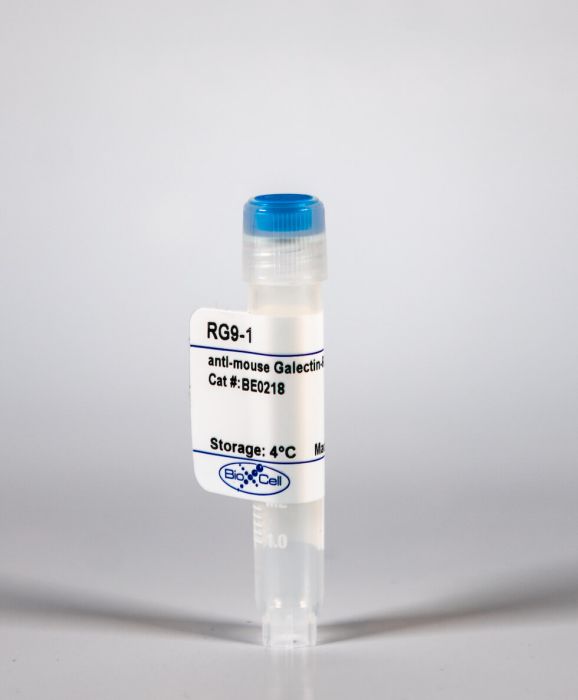InVivoMAb anti-mouse Galectin-9
Product Details
The RG9-1 monoclonal antibody reacts with mouse galectin-9 a 40 kDa S-type lectin that is expressed by various cell types including lymphocytes, thymocytes, macrophages, dendritic cells, astrocytes, mast cells, eosinophils, fibroblasts, epithelial cells, and endothelial cells. Galectin-9 binds to β-galactosides and can serve as a ligand for TIM-3 (CD366). The protein is implicated in both innate and adaptive immune responses specifically, induction of cytokine secretion by macrophages, bactericidal functions, promotion of dendritic cell maturation, regulatory T cell expansion, and negative regulation of Th1, Th17, NK, and cytotoxic T cells. The RG9-1 antibody has been reported to block some biological activities of Galectin-9 when administered in vivo.Specifications
| Isotype | Rat IgG2b, κ |
|---|---|
| Recommended Isotype Control(s) | InVivoMAb rat IgG2b isotype control, anti-keyhole limpet hemocyanin |
| Recommended Dilution Buffer | InVivoPure pH 7.0 Dilution Buffer |
| Immunogen | Recombinant mouse galectin-9 |
| Reported Applications | in vivo Galectin-9 blockade in vitro Galectin-9 blockade |
| Formulation |
PBS, pH 7.0 Contains no stabilizers or preservatives |
| Endotoxin |
<2EU/mg (<0.002EU/μg) Determined by LAL gel clotting assay |
| Sterility | 0.2 μM filtered |
| Production | Purified from tissue culture supernatant in an animal free facility |
| Purification | Protein G |
| RRID | AB_2687702 |
| Molecular Weight | 150 kDa |
| Storage | The antibody solution should be stored at the stock concentration at 4°C. Do not freeze. |
Recommended Products
in vivo Galectin-9 blockade, in vitro Galectin-9 blockade
de Mingo Pulido, A., et al. (2018). "TIM-3 Regulates CD103(+) Dendritic Cell Function and Response to Chemotherapy in Breast Cancer" Cancer Cell 33(1): 60-74 e66. PubMed
Intratumoral CD103(+) dendritic cells (DCs) are necessary for anti-tumor immunity. Here we evaluated the expression of immune regulators by CD103(+) DCs in a murine model of breast cancer and identified expression of TIM-3 as a target for therapy. Anti-TIM-3 antibody improved response to paclitaxel chemotherapy in models of triple-negative and luminal B disease, with no evidence of toxicity. Combined efficacy was CD8(+) T cell dependent and associated with increased granzyme B expression; however, TIM-3 expression was predominantly localized to myeloid cells in both human and murine tumors. Gene expression analysis identified upregulation of Cxcl9 within intratumoral DCs during combination therapy, and therapeutic efficacy was ablated by CXCR3 blockade, Batf3 deficiency, or Irf8 deficiency.
in vivo Galectin-9 blockade
Daley, D., et al. (2016). "gammadelta T Cells Support Pancreatic Oncogenesis by Restraining alphabeta T Cell Activation" Cell 166(6): 1485-1499 e1415. PubMed
Inflammation is paramount in pancreatic oncogenesis. We identified a uniquely activated gammadeltaT cell population, which constituted approximately 40% of tumor-infiltrating T cells in human pancreatic ductal adenocarcinoma (PDA). Recruitment and activation of gammadeltaT cells was contingent on diverse chemokine signals. Deletion, depletion, or blockade of gammadeltaT cell recruitment was protective against PDA and resulted in increased infiltration, activation, and Th1 polarization of alphabetaT cells. Although alphabetaT cells were dispensable to outcome in PDA, they became indispensable mediators of tumor protection upon gammadeltaT cell ablation. PDA-infiltrating gammadeltaT cells expressed high levels of exhaustion ligands and thereby negated adaptive anti-tumor immunity. Blockade of PD-L1 in gammadeltaT cells enhanced CD4(+) and CD8(+) T cell infiltration and immunogenicity and induced tumor protection suggesting that gammadeltaT cells are critical sources of immune-suppressive checkpoint ligands in PDA. We describe gammadeltaT cells as central regulators of effector T cell activation in cancer via novel cross-talk.
in vivo Galectin-9 blockade
Dolina, J. S., et al. (2014). "Liver-primed CD8+ T cells suppress antiviral adaptive immunity through galectin-9-independent T-cell immunoglobulin and mucin 3 engagement of high-mobility group box 1 in mice" Hepatology 59(4): 1351-1365. PubMed
The liver is a tolerogenic environment exploited by persistent infections, such as hepatitis B (HBV) and C (HCV) viruses. In a murine model of intravenous hepatotropic adenovirus infection, liver-primed antiviral CD8(+) T cells fail to produce proinflammatory cytokines and do not display cytolytic activity characteristic of effector CD8(+) T cells generated by infection at an extrahepatic, that is, subcutaneous, site. Importantly, liver-generated CD8(+) T cells also appear to have a T-regulatory (Treg) cell function exemplified by their ability to limit proliferation of antigen-specific T-effector (Teff ) cells in vitro and in vivo via T-cell immunoglobulin and mucin 3 (Tim-3) expressed by the CD8(+) Treg cells. Regulatory activity did not require recognition of the canonical Tim-3 ligand, galectin-9, but was dependent on CD8(+) Treg cell-surface Tim-3 binding to the alarmin, high-mobility group box 1 (HMGB-1). CONCLUSION: Virus-specific Tim-3(+) CD8(+) T cells operating through HMGB-1 recognition in the setting of acute and chronic viral infections of the liver may act to dampen hepatic T-cell responses in the liver microenvironment and, as a consequence, limit immune-mediated tissue injury or promote the establishment of persistent infections.



